Physical Address
304 North Cardinal St.
Dorchester Center, MA 02124
Since the discovery of renal oncocytoma in 1976, the classification of tumors of the kidney has grown complex. In the following sections on epithelial tumors, mesenchymal tumors, and tumors of children, the diagnostic and prognostic aspects of renal neoplasia are presented with emphasis on the gross pathology and histologic examination, including recently recognized and rare entities.
Notwithstanding the historic problems and success of surgery, it is our view that the data support the definition of a set of criteria within which the diagnosis of papillary adenoma is safe and justified ( Box 12A.1 ). The first criterion indicates that the microscopic morphology of papillary adenoma resembles that of papillary renal cell carcinoma, including lesions with both type 1 and type 2 characteristics. The second criterion (size) defines a group of tumors that appears to be limited in growth potential. This includes more than 95% of all papillary neoplasms of the renal tubules. Larger ones are more worrisome because they have demonstrated a greater capacity for growth and may have the potential for metastasis. The third criterion reflects the fact that there is no convincing evidence that very small tumors of other cell types in this location are not small carcinomas.
Papillary or tubulopapillary architecture
Diameter ≤15 mm
Does not histologically resemble clear cell, chromophobe, or collecting duct renal cell carcinomas
The frequency of small epithelial tumors in the cortices of kidneys has ranged up to 37% in autopsy patients, depending upon the patient population and study methods. The frequency of small papillary tumors increases with age to approximately 40% of the population over age 65. Similar lesions frequently develop in patients on long-term hemodialysis and have been reported in up to 33% of patients with acquired renal cystic disease. The association between arteriosclerotic renal vascular disease and papillary adenomas has long been recognized. Budin and McDonnell studied autopsy material and found that the prevalence of papillary adenomas not only was much increased in kidneys with arteriosclerotic renal vascular disease but that this was independent of age. Xipell found a strong correlation between tobacco smoking and the presence of papillary adenomas; this also was observed by Bennington.
That kidneys bearing renal cell carcinoma or oncocytoma are more likely to contain papillary adenomas than normal kidneys has long been recognized. Occasionally, more than one adenoma will be present adjacent to the carcinoma or oncocytoma, as if some local factor were promoting the development of the adenomas.
Papillary adenomas appear to the naked eye as well circumscribed, yellow to grayish white nodules in the renal cortex. Most occur just below the renal capsule but ones that are invisible from the cortical surface are fairly common. The smallest ones usually are spherical, but larger ones sometimes are roughly conical with a wedge-shaped appearance in sections cut at right angles to the cortical surface. An association with scars in the renal cortex has been asserted but is controversial. In most patients, adenomas are solitary, but occasionally papillary adenomas are multiple and bilateral, rarely miliary; this condition has been called renal adenomatosis.
Papillary adenomas have papillary, tubular, or tubulopapillary architectures ( Fig. 12A.1 ). Some are surrounded by thin fibrous pseudocapsules while others have none. The cells have round to oval nuclei with chromatin, which ranges from stippled to clumped, and inconspicuous nucleoli. Mitotic figures usually are absent. In most papillary adenomas, the cytoplasm is scant and pale, faintly basophilic. Occasionally it is slightly more voluminous and appears clear or filled with minute vacuoles. Less frequently, the cytoplasm is voluminous and eosinophilic, resembling type 2 papillary renal cell carcinoma. Psammoma bodies are often present, as are foamy macrophages.
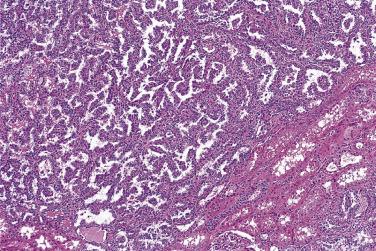
Almost all papillary adenomas react with antibodies to epithelial membrane antigen and low-molecular-weight cytokeratin, while a majority react with antibodies to high-molecular-weight cytokeratin. Papillary adenomas frequently have the gains of chromosomes 7 and 17 and loss of the Y chromosome, typical of papillary renal cell carcinoma.
Renal oncocytomas are neoplasms of the renal cortex, which often are discovered incidentally by radiologic examinations of the kidneys for other reasons but which may also present as a palpable mass or with hematuria. In 1976 Klein and Valensi drew attention to renal oncocytoma as a renal tumor previously classified as renal cell carcinoma but distinguishable from it by its pathologic features and benign course. There is a 2 : 1 preponderance of males to females and almost all cases have occurred in adults, mostly from ages 50 to 80. Resection of the tumor is curative. A striking spoke-and-wheel appearance on radiography was at first thought to be diagnostic of oncocytoma, but greater experience has indicated that this is not specific because renal cell carcinomas may have similar appearances. The tumor cannot reliably be distinguished preoperatively from renal cell carcinoma by imaging. Thus nephrectomy is the usual operation. However, a number of patients have had multicentric or bilateral tumors and conservative operations have been successful when performed for these reasons.
The most characteristic feature of renal oncocytoma is its brown color ( Fig. 12A.2 ), which contrasts with the bright yellow color typical of clear cell renal cell carcinomas. Many oncocytomas have central zones of whitish stroma which may connect with the periphery ( Fig. 12A.3 ), giving the subcapsular surface a bosselated contour. Occasional tumors exhibit foci of hemorrhage but necrosis is rare, and often can be related to extrinsic factors. Generally the presence of gross necrosis or hemorrhage suggests extra caution in making the diagnosis of oncocytoma. Bilaterality or unilateral multicentricity occurs in approximately 4% of cases and is more frequent than with renal cell carcinoma.
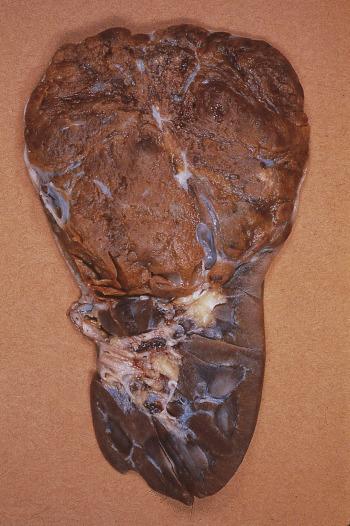
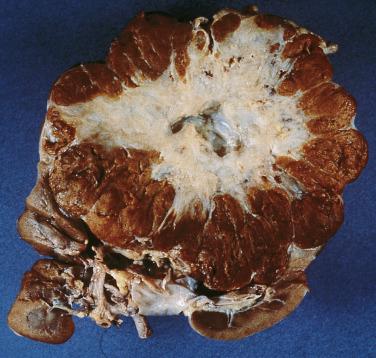
The cells usually are arranged either in diffuse sheets or as cellular islands in a background of loose edematous connective tissue ( Fig. 12A.4 ). Small cysts are common. Rarely the groups of cells contain hyaline deposits of type IV collagen, giving a cylindromatous appearance. In sections stained with hematoxylin and eosin, the cytoplasm is intensely eosinophilic and finely granular. While the cytoplasmic volume ranges from moderate to abundant, its staining qualities are the same. The nuclei are mainly round with clumps of chromatin and nucleoli which may be visible with a 10× microscope objective. Occasionally bizarre, enlarged nuclei, sometimes containing cytoplasmic invaginations, may be present ( Fig. 12A.5 ). Mitotic figures are absent or very rare in oncocytomas. Because they are benign, oncocytomas are not graded. By electron microscopy, the cytoplasm is seen to be filled with mitochondria and other organelles are scant ( Fig. 12A.6 ).
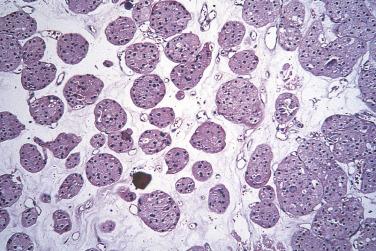
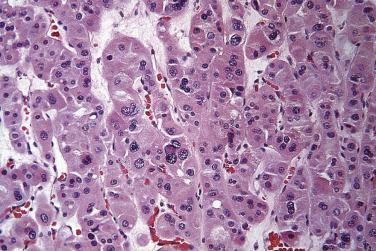
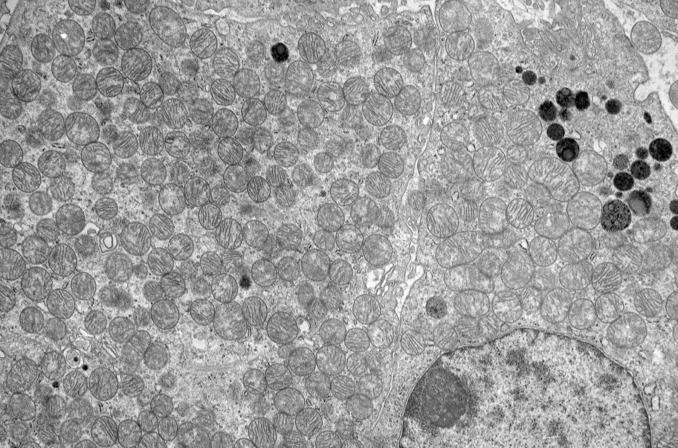
Extension into small veins is seen microscopically in a little more than 5% of cases and appears to have no adverse prognostic significance. Small extensions into perirenal fat are seen in almost 10% of cases and also appear to have no adverse effect.
The principal consideration is the eosinophilic variant of chromophobe renal cell carcinoma. In most cases, strict adherence to the criteria listed in Box 12A.2 will enable this distinction. Immunohistochemistry can be helpful since oncocytomas typically express cytokeratin 7 in scattered single cells or small clusters of cells, while chromophobe renal cell carcinomas usually express cytokeratin 7 in almost every cell, with accentuation of the signal at the cell membrane.
Finely granular strongly eosinophilic cytoplasm
Sheet, insular, or tubulocystic architectural patterns
Mitochondria filling cytoplasm with other organelles and microvilli sparse
Microscopic vascular invasion
Microscopic extension into perirenal fat
Mitotic figures
Papillary architecture
Clear or spindle cells
Positive colloidal iron stain or chromophobe-type vesicles seen by electron microscopy
Gross vascular invasion
Gross extension into perirenal fat
In 1980 Pagès and Granier drew attention to a previously unrecognized renal neoplasm they called néphrome néphronogène (nephronogenic nephroma) and considered to be a purely epithelial neoplasm arising from persistent blastema. Since that time, more than 100 cases have been described individually or in aggregated studies and the name metanephric adenoma has become accepted.
In 1992 Hennigar and Beckwith described five cases of a composite neoplasm in which an epithelial component identical to metanephric adenoma was combined with a proliferation of spindle cells; they proposed the name nephrogenic adenofibroma for this tumor. However, the name metanephric adenofibroma has been adopted for these tumors to emphasize their close relationship with metanephric adenoma.
Metanephric adenoma occurs at all ages, most commonly in the fifth and sixth decades and there is a 2 : 1 female preponderance. Metanephric adenoma is the most common epithelial tumor found in the kidneys of children. Approximately 50% are incidental findings while others present with polycythemia, abdominal or flank pain, mass, or hematuria. Often the polycythemia resolved after the tumor was removed. Cases reported to date have neither recurred nor metastasized. Four of the 50 patients reported by Davis et al. also had renal cell carcinoma.
Patients with metanephric adenofibroma have ranged from 13 months to 36 years (median 28 months). While the number of cases is small, there does not appear to be any gender predominance. More than 50% of the patients have had polycythemia. Other symptoms of metanephric adenofibroma have included hematuria and hypertension. Some have been incidental findings. Three of the five cases reported by Hennigar and Beckwith had separate small papillary epithelial tumors near the renal pelvis which they considered low-grade collecting duct carcinomas.
Metanephric adenomas have ranged widely in size with the largest being 150 mm in diameter; most have been 30 to 60 mm in diameter. Davis et al. found no instance of bilaterality and only two instances of unilateral multifocality in 50 patients. The tumors are typically well circumscribed but in most instances are not encapsulated. A thin and discontinuous pseudocapsule is more common than a substantial one. The cut surfaces vary from gray to tan to yellow and may be soft or firm. Calcification is present in approximately 20% and a few are densely calcified. Small cysts are present in about 10% of tumors and a unique example was entirely cystic. Foci of hemorrhage and necrosis are common. Metanephric adenofibromas are typically solitary, firm, bosselated masses without capsules and with indistinct borders. The cut surfaces range from gray to tan to yellow and solid with only occasional cysts in some of the tumors.
Histologically metanephric adenoma is typically a highly cellular tumor composed of tightly packed small, uniform, round acini ( Fig. 12A.7 ). Since the acini and their lumens are so small, at low magnification this pattern may be mistaken for a solid sheet of cells. Long branching and angulated tubular structures also are common. The stroma ranges from inconspicuous to a loose paucicellular edematous stroma. Hyalinized scar or focal osseous metaplasia of the stroma are present in 10% to 20% of tumors. Approximately 50% of tumors contain papillary structures, usually consisting of minute cysts into which have grown short blunt papillae reminiscent of immature glomeruli. In most of these, no blood vessel is visible. Psammoma bodies are common and may be numerous. The junction with the kidney is usually abrupt and lacking a pseudocapsule.
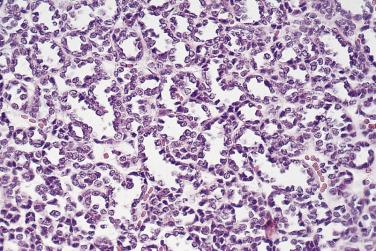
The cells of metanephric adenoma have small, uniform nuclei with absent or inconspicuous nucleoli. The nuclei are only slightly larger than lymphocytes and are round or oval and have delicate chromatin. The cytoplasm is scant and pale or light pink. Mitotic figures are absent or rare.
Metanephric adenofibroma is a composite tumor in which nodules of epithelium identical to metanephric adenoma are embedded in sheets of moderately cellular spindle cells. The spindle cell component consists of fibroblast-like cells ( Fig. 12A.8 ). Their cytoplasm is eosinophilic but pale and the nuclei are oval or fusiform. Nucleoli are inconspicuous and mitotic figures are absent or rare. Variable amounts of hyalinization and myxoid change are present. The relative amounts of the spindle cell and epithelial components vary from predominance of spindle cells to a minor component of spindle cells. The border of the tumor with the kidney is typically irregular and the spindle cell component may entrap renal structures as it advances. The epithelial component consists of small acini, tubules and papillary structures, as described earlier in metanephric adenoma. Psammoma bodies are common and may be numerous. Neither metanephric adenoma nor metanephric adenofibroma contains blastema nor is either associated with nephrogenic rests.

Metanephric adenoma and the epithelial component of metanephric adenofibroma frequently show positive intranuclear reactivity with antibodies to WT1. CD57 is frequently positive in metanephric adenomas and racemase (P504S) is negative, which reactions are helpful in the differential diagnosis with papillary renal cell carcinoma. Metanephric adenomas lack the gains of chromosomes 7 and 17 and losses of the Y chromosome typical of papillary renal cell carcinomas.
At first inspection, metanephric adenoma brings Wilms tumor to mind because of the dense array of small blue cells and epithelial differentiation. However, the nuclei of metanephric adenoma are smaller and lack the elongation and tapered ends often present in the nuclei of epithelial cells in Wilms tumor. Further, mitotic figures are rare in metanephric adenoma and blastema is not present. The fibromatous component of metanephric adenofibroma could be mistaken for the stroma of Wilms tumor but cytologically it is benign and lacks the variety of differentiation often seen in the stroma of Wilms tumor.
The other major consideration is papillary renal cell carcinoma, type 1. The small cytoplasmic volume, papillary structures, and psammoma bodies bring this to mind. However, most metanephric adenomas are composed mainly of arrays of fairly uniform structures resembling renal tubules in cross section. This architecture is not typical of papillary renal cell carcinoma. Additionally, metanephric adenomas often have long pointed, branching channels lined by epithelial cells. These are not found in papillary renal cell carcinoma, nor in Wilms tumor. The edema of papillary cores and collections of stromal foam cells which are common in papillary renal cell carcinoma are not typical of metanephric adenoma. Metanephric adenomas frequently express WT1, which can help to differentiate them from papillary renal cell neoplasms as can fluorescent in situ hybridization (FISH) for the chromosomes commonly gained by papillary renal cell neoplasms.
Renal cell carcinoma is a family of carcinomas which arise from the epithelium of the renal tubules. The carcinomas have distinct morphologic features and arise through different constellations of genetic lesions. The classification of renal cell carcinoma is presented in Box 12A.3 .
Papillary adenoma
Oncocytoma
Metanephric adenoma
Clear cell renal cell carcinoma
Multilocular cystic renal neoplasm of low malignant potential
Papillary renal cell carcinoma
Type 1
Type 2
Herditary leiomyomatosis and renal cell carcinoma–associated renal cell carcinoma
Chromophobe renal cell carcinoma
Classic
Eosinophilic
Collecting duct carcinoma
Renal medullary carcinoma
MiT family translocation renal cell carcinomas
Succinate dehydrogenase-deficient renal cell carcinoma
Mucinous tubular and spindle cell carcinoma
Tubulocystic carcinoma
Acquired cystic disease–associated renal cell carcinoma
Clear cell papillary renal cell carcinoma
Renal medullary carcinoma
Unclassified renal cell carcinoma
Neuroendocrine neoplasms
Carcinoid
Small cell carcinoma
Because the recognition that renal cell carcinoma comprises a family of diseases arising through different genetic lesions is relatively new, much of the clinical and epidemiologic information presently available comes from studies in which all types of renal cell carcinoma were lumped together. This applies to the following generalizations. Renal cell carcinoma is almost exclusively a cancer of adults. Approximately 60,000 new cases are diagnosed each year in the United States and approximately 340,000 worldwide. Its incidence increases with each decade of life until the sixth and it is twice as common in males as in females. Renal cell carcinoma is rare in the first two decades of life, comprising only 2% of pediatric renal tumors. Although obesity, smoking, and exposure to industrial chemicals have been implicated as risk factors in the genesis of renal cell carcinomas, in most cases the carcinogenic influence is unclear. An association with von Hippel-Lindau disease is seen in occasional cases and 33% to 50% of these patients develop renal cell carcinoma. Acquired renal cystic disease arising in patients with chronic renal failure also is strongly associated with renal cell carcinoma. Paraneoplastic syndromes of hypercalcemia, erythrocytosis, hypertension, and amyloidosis have occasionally been associated with renal cell carcinoma. Renal cell carcinoma also is notorious for presenting as metastatic carcinoma of unknown primary, sometimes in unusual sites.
The clinical course of renal cell carcinoma is notably unpredictable with well-documented cases of spontaneous regression of metastases. Recurrences of 5 years or more after nephrectomy occur in a significant fraction of patients who survive that long. There is some evidence that resection of solitary metastases improves survival, while the presence of multiple metastases indicates a worse prognosis. Metastases to bone occur frequently.
Approximately two-thirds to three-quarters of all renal cell carcinomas are clear cell renal cell carcinoma. This name is given to these tumors because most of them are composed wholly or partially of cells with abundant clear cytoplasm. However, clear cell renal cell carcinoma is merely a name, and many of these carcinomas have extensive areas in which the cytoplasm is eosinophilic, and rare examples are composed entirely of cells with eosinophilic cytoplasm.
Clear cell renal cell carcinomas are characterized by loss of genetic material on 3p, ranging from loss of whole chromosomes to loss of function through hypermethylation. Other genetic abnormalities are common and there is evidence that alterations on chromosomes 14, 8, and 9 affect prognosis.
Overall, clear cell renal cell carcinoma has a somewhat worse prognosis than the other common types of renal cell carcinoma. Several nomograms have been constructed to combine stage and other factors to predict prognosis in clear cell renal cell carcinoma.
Clear cell renal cell carcinomas are typically globular masses which may arise anywhere in the renal cortex ( Fig. 12A.9 ) and often protrude beyond the normal contour of the kidney. However, they occasionally grow inward or are diffusely infiltrative. The cut surface is usually variegated ( Fig. 12A.10 ), composed of soft bright yellow parenchyma with areas of grayish edematous stroma, hemorrhage, necrosis, and cysts. The cysts are filled with clear straw-colored fluid or with hemorrhage. Clear cell renal cell carcinoma may invade the renal venous system, occasionally filling the renal vein and extending into the vena cava or even the right atrium. Approximately 5% of clear cell renal cell carcinomas have areas of sarcomatoid change. These tend to appear grossly as firm solid whitish tissue ( Fig. 12A.11 ).
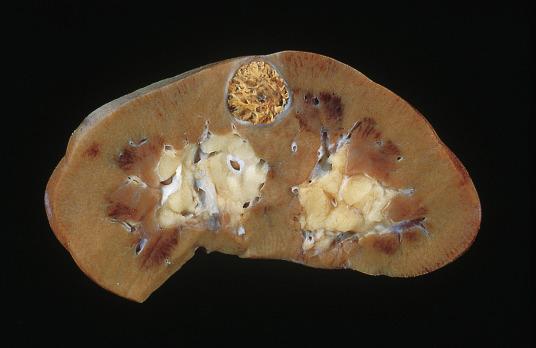
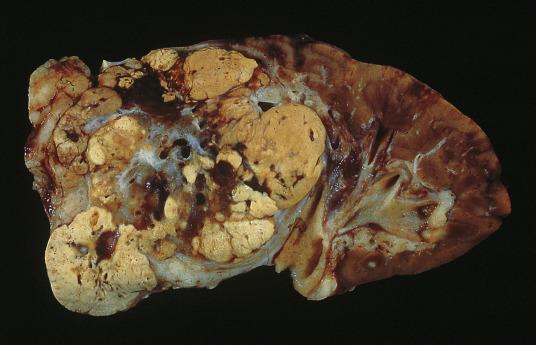
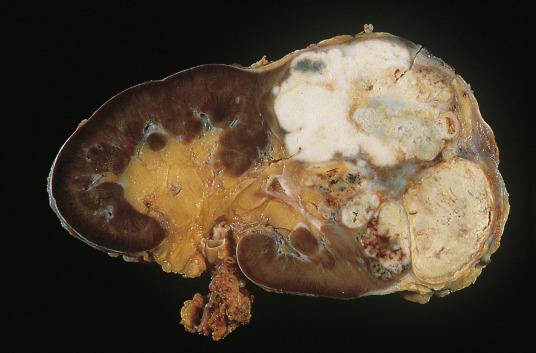
Rarely cystic masses ( Fig. 12A.12 ) grossly resembling cystic nephroma and meeting the criteria listed in Box 12A.4 contain aggregates of clear epithelial cells within their septa. These cells almost always have small dark-staining nuclei and are histologically identical to nuclear grade 1 clear cell renal cell carcinoma. Because there is little or no evidence of malignant behavior by such tumors, they should be diagnosed as multilocular cystic renal neoplasm of low malignant potential .
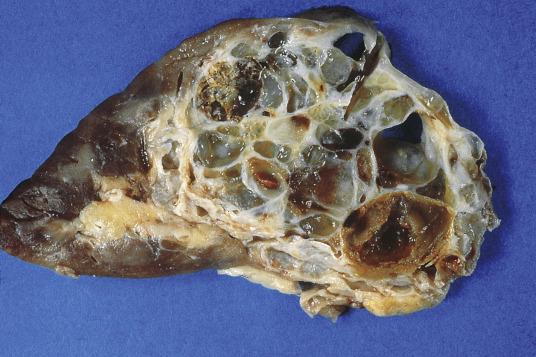
Expansile mass surrounded by fibrous pseudocapsule
Interior of tumor entirely composed of cysts and septa with no expansile solid nodules
Septa contain aggregates of epithelial cells with clear cytoplasm
Clear cell renal cell carcinomas typically have a network of small blood vessels which invest alveolar clusters of carcinoma cells ( Fig. 12A.13 ). These blood vessels are very delicate and of a uniform small caliber. This vascular pattern is of great help in diagnosis since it is particular to clear cell renal cell carcinoma and not found in other types of renal cell carcinoma.
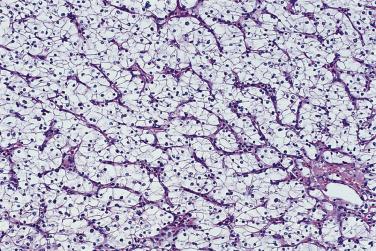
While a solid sheet of alveoli is a common pattern of growth, the alveoli often have small central lumens which contain freshly extravasated erythrocytes. Commonly, some of the lumens are larger, forming microscopic cysts of variable size ( Fig. 12A.14 ). Among renal cell carcinomas, clear cell renal cell carcinoma is the one most prone to the formation of small and large cysts—a helpful diagnostic clue.
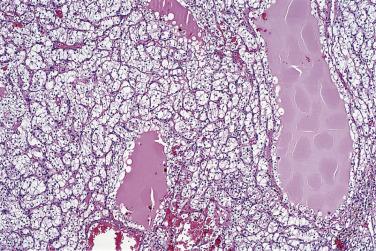
The cytoplasmic volume of clear cell renal cell carcinoma is variable over a range from moderate to voluminous. However, it is typical that the cells in one area of a tumor are similar in size. This zonal pattern of cellular sizes contrasts with the mosaic pattern characteristic of chromophobe renal cell carcinoma. The clarity of the cytoplasm is caused by the abundant lipid and glycogen which dissolve in tissue processing.
One should think twice before diagnosing a tumor with obvious papillary architecture as clear cell renal cell carcinoma. If they occur at all, psammoma bodies and foamy macrophages, which are common in papillary renal cell carcinoma, are extremely rare in clear cell renal cell carcinoma. Mucin is at most rare in clear cell renal cell carcinoma, and some would categorize tumors containing mucin as renal cell carcinoma, unclassified.
The diagnosis of the typical clear cell renal cell carcinoma is usually straightforward. Sarcomatoid change occurs in approxmimately 5% of clear cell renal cell carcinomas and may cause difficulty because it very closely mimics a sarcoma. This problem is well known however, and because of the rarity of renal sarcomas, they should be diagnosed with caution. Extensive sampling may be helpful since these tumors frequently have foci, albeit sometimes small, of typical renal cell carcinoma which make the correct diagnosis obvious. Immunohistochemistry for epithelial markers usually demonstrates epithelial features in cells that appear sarcomatous in sections stained with hematoxylin and eosin.
In adults, urothelial carcinomas of the renal pelvis may be confused with renal cell carcinomas, especially when tumors are large and extensively infiltrate the kidney. Microscopically, the diagnosis may be difficult, particularly when the pelvic tumor is predominantly sarcomatoid. Extensive sampling may be necessary to find small areas of typical urothelial carcinoma, even in situ, or renal cell carcinoma.
Clinically occult renal cell carcinomas presenting at distant sites with unknown primaries or recurring years after an apparently successful nephrectomy may pose special diagnostic problems. Positive immunohistochemistry for PAX8 can help to indicate renal origin. Also the coexpression of cytokeratin and vimentin, which occurs in a majority of clear cell renal cell carcinomas, is unusual among carcinomas and should be taken as suggestive of a renal primary when found in a metastasis of unknown origin. Solitary metastasis to the contralateral adrenal can resemble primary adrenal cortical carcinoma. In such cases, immunohistochemical staining for epithelial membrane antigen and cytokeratins can be helpful since renal cell carcinomas almost always stain for epithelial membrane antigen or cytokeratin, or both, while adrenal cortical carcinomas do not contain epithelial membrane antigen and stain for cytokeratin only weakly. Further immunohistochemistry for inhibin and melan-A can also be helpful. Metastasis to the thyroid can mimic clear cell carcinoma of the thyroid ; thyroglobulin, or TTF-1, immunohistochemistry can be helpful in making the distinction. Metastases to the ovary can be confused with primary ovarian clear cell adenocarcinoma. Capillary hemangioblastoma of the central nervous system may closely resemble clear cell renal cell carcinoma in sections stained with hematoxylin and eosin and poses a particular problem because both neoplasms are associated with von Hippel-Lindau disease. This problem can usually be resolved by staining for epithelial membrane antigen, since capillary hemangioblastomas fail to stain, while renal cell carcinomas usually do.
Approximately 10% to 15% of renal cell carcinomas in surgical series are papillary renal cell carcinomas. Males predominate in a ratio of approximately 2 : 1. Ages range from early adulthood to old age, with the mean between 50 and 55 years. The outlook for these patients is somewhat better than for those with clear cell renal cell carcinoma and a nomogram has been constructed to combine factors predictive of prognosis in these patients.
Papillary renal cell carcinoma has a characteristic pattern of chromosomal gains and losses which differs from that of other renal cell neoplasms. Most commonly, these are trisomy or tetrasomy of 7 and 17 and most papillary renal cell carcinomas in men lose the Y chromosome.
Papillary renal cell carcinomas usually are well-circumscribed, globular tumors with pale tan or brown parenchyma. In about two-thirds of cases, hemorrhage and necrosis are prominent, which may cause the tumor to appear hypovascular radiographically. Many of these carcinomas are large. Often the cut surface is friable or granular, a reflection of the papillae seen microscopically. The larger tumors are often surrounded by a rim of dense fibrous tissue. In about one-third of cases, there are calcifications.
The architecture is predominantly papillary or tubulopapillary in more than 90% of papillary renal cell carcinomas. Tight packing of papillae imparts the appearance of a solid growth pattern in some tumors. The papillae usually have delicate fibrovascular cores covered by a single layer of cells. The form of the papillae varies, ranging from complex branching to long parallel arrays. The cores are sometimes expanded by foamy macrophages ( Fig. 12A.15 ) or edema fluid. Psammoma bodies occasionally are present. Rarely the papillary cores are wide and collagenous. The tubular architecture consists of small tubules lined by a single layer of cells identical to those covering papillae.
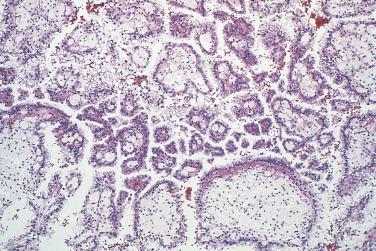
There are two types of papillary renal cell carcinoma, which Delahunt and Eble have designated type 1 and type 2. Type 1 is more common than type 2. In type 1, the cells usually are small, with inconspicuous pale cytoplasm ( Fig. 12A.16 ). The nuclei are typically uniform, nearly spherical, and small, with nearly or completely invisible nucleoli. In type 2, the cells are usually larger and often have abundant eosinophilic cytoplasm. The nuclei are arranged in a pseudostratified pattern, are large, spherical, and often have prominent nucleoli ( Fig. 12A.17 ). The two types differ in their genetic aberations and in their prognoses.
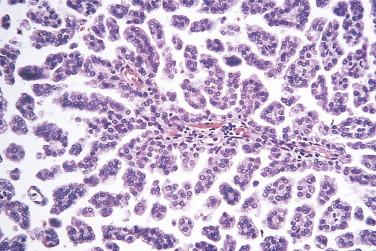
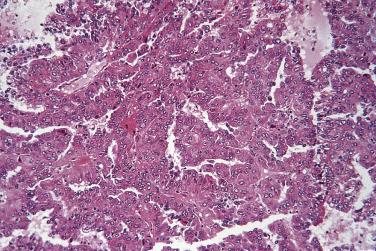
Nuclear grading is recommended for papillary renal cell carcinomas.
In children and adolescents, papillary renal cell carcinomas must be distinguished from Wilms tumors with epithelial predominance. Beckwith emphasized the similarity of some Wilms tumors to typical renal cell carcinoma. Thorough sampling of such tumors usually will reveal blastema or differentiated stroma (e.g., skeletal muscle) and the diagnosis of Wilms tumor will be made with relative ease. The appearance of the nuclei—elongate with tapered ends in the epithelium of Wilms tumor and spheroidal in renal cell carcinoma—also may be helpful. The diagnosis of papillary renal cell carcinoma in a young person should be made only after epithelial predominant Wilms tumor has been excluded.
In 2001 an hereditary syndrome in which uterine and cutaneous leiomyomas were associated with renal cell carcinoma was discovered. Shortly thereafter germline mutations in the fumarate hydratase ( FH ) gene were found to be the cause of the syndrome. Ovarian steroid cell tumors and macronodular adrenocortical hyperplasia may also be parts of the syndrome. The uterine leiomyomas arise in young women and frequently are so symptomatic that early hysterectomy is required. In the leiomyomas, the nuclei often have large nucleoli. It is estimated that 15% of people with the mutation will develop renal cell carcinoma. Patients with renal carcinomas usually present with solitary tumors at a mean age in the early fourth decade. Metastases are extremely common (around 80% of patients) and nearly all patients with metastases have died of disease.
The tumors range widely in size and invasion of perirenal fat and extension into the renal vein and vena cava occur frequently. The tumors are predominantly solid but about 50% have at least a minor cystic component.
Papillary architecture is present in more than 50% of tumors, but tubular architecture is common and about 20% are mixtures of papillary and tubular architectures. A cystic component is present in about half ( Fig. 12A.18 ). The cytoplasm is typically abundant and eosinophilic, but foci of clear cytoplasm can be present. The nuclei are large and typically contain large eosinophilic nucleoli surrounded by haloes ( Fig. 12A.19 ). Mitotic figures usually are present, ranging from two to six per high-power field (hpf).
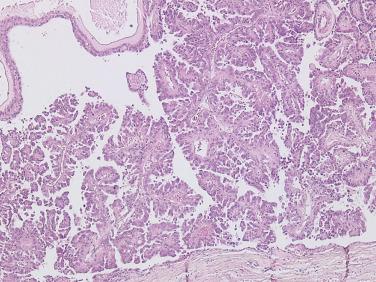
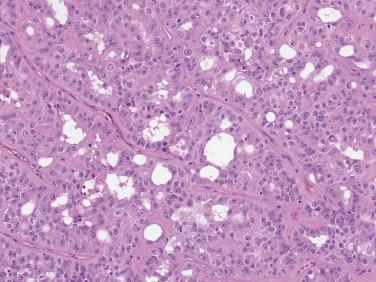
Hereditary leiomyomatosis and renal cell carcinoma syndrome carcinomas can have areas resembling papillary renal cell carcinoma, type 2, tubulocystic carcinoma, collecting duct carcinoma, or renal oncocytoma. Immunohistochemistry can usually resolve questions of differential diagnosis: In hereditary leiomyomatosis and renal cell carcinoma–associated carcinomas immunohistochemistry for fumarate hydratase gives a negative result in the neoplastic cells, while nonneoplastic cells serve as positive internal controls. S-(2-succino)-cysteine was detected immunohistochemically in all hereditary leiomyomatosis and renal cell carcinoma renal tumors and seldom was detectable in type 2 papillary renal cell carcinomas and other tumors with histologic appearances overlapping them. Of course, a clinical history of cutaneous leiomyomas or early onset of uterine leiomyomas also is helpful.
In 1985 Thoenes et al. first described and named chromophobe renal cell carcinoma. Since then it has become apparent that approximately 5% of renal cell carcinomas are chromophobe renal cell carcinomas. The genetic hallmark of chromophobe renal cell carcinoma is the loss of multiple chromosomes.
It appears that chromophobe renal cell carcinoma is less aggressive than clear cell and papillary renal cell carcinomas and surgery is usually curative. Sarcomatoid change occurs in chromophobe renal cell carcinoma at about the same frequency as in the other types of renal cell carcinoma and appears to account for a substantial fraction of the deaths.
Chromophobe renal cell carcinomas are usually well-circumscribed globular solid tan or brown tumors ( Fig. 12A.20 ). Formalin fixation may change their color to a pale off-white. Large cysts are not typical of chromophobe renal cell carcinoma.
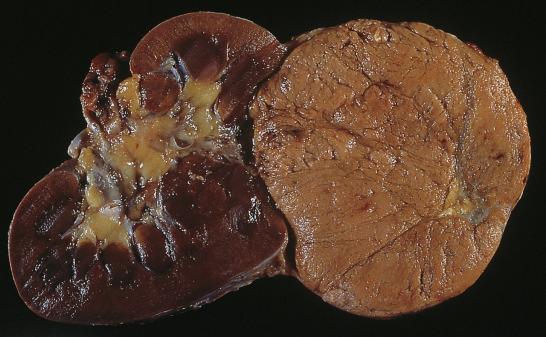
Chromophobe renal cell carcinoma is characterized by the presence of cells with large numbers of minute intracytoplasmic vesicles which impart a pale, reticular or flocculent appearance to the cytoplasm in hematoxylin and eosin ( Fig. 12A.21 ). The vesicles are demonstrable by electron microscopy ( Fig. 12A.22 ). The Hale colloidal iron stain colors the cytoplasm blue ( Fig. 12A.23 ). The initial descriptions emphasized the well-defined thick cytoplasmic membranes and lightly staining flocculent cytoplasm of what is now called the typical variant of chromophobe renal cell carcinoma. The typical variant also has thick-walled blood vessels. The cells range widely in size and small and large cells are mixed together in a mosaic pattern. Later, the eosinophilic variant of chromophobe cell renal cell carcinoma was recognized. This variant shares the ultrastructural and colloidal iron staining features of the typical variant but, in hematoxylin and eosin-stained slides, closely resembles renal oncocytoma ( Fig. 12A.24 ). It is prudent to perform a colloidal iron stain on any tumor in which the differential diagnosis includes renal oncocytoma and chromophobe cell renal cell carcinoma.
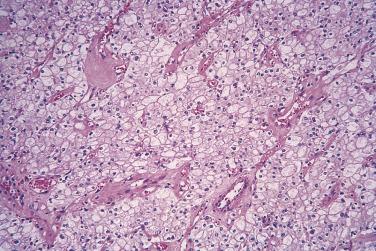
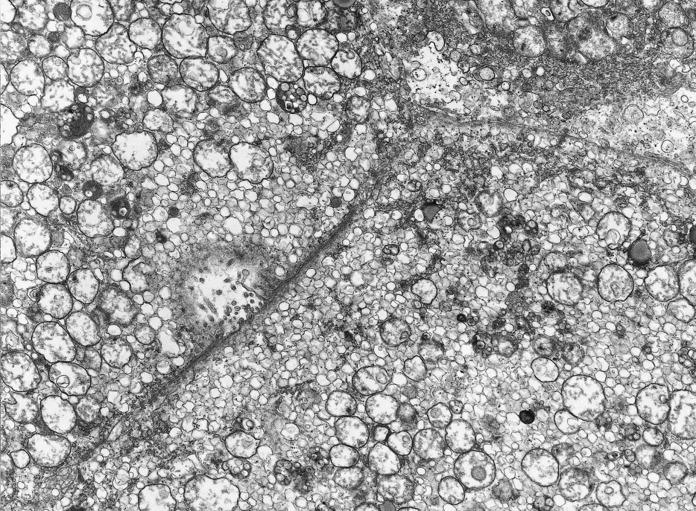
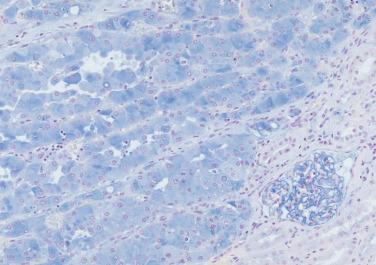
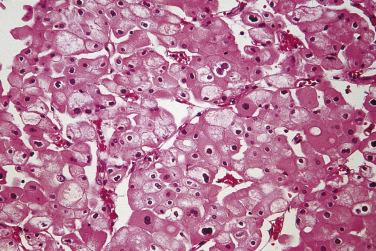
The vasculature, mosaic pattern of variability of cell size, and cytoplasmic characteristics make the classical form of chromophobe renal cell carcinoma distinctive; and diagnosis can usually be easily achieved in routine sections. The eosinophilic variant is more problematic because of its close resemblance to oncocytoma. In sections stained with hematoxylin and eosin, perinuclear haloes, wrinkled irregular nuclei, and microcystic architecture lend support to the diagnosis of the eosinophilic variant of chromophobe renal cell carcinoma. However, histochemical staining with the Hale colloidal iron reaction is helpful and a diffuse cytoplasmic positive reaction supports the diagnosis of chromophobe renal cell carcinoma, while a diffusely negative reaction supports oncocytoma. Immunohistochemistry for cytokeratin 7 usually shows a strong diffusely positive reaction in chromophobe renal cell carcinomas. Chromophobe renal cell carcinomas are typically negative for vimentin.
The collecting ducts begin in the renal cortex and descend through the medulla to the renal papillae ( Fig. 12A.25 ); the short segments just above the papillary orifices are called the ducts of Bellini. There is evidence that the intercalated cells of the collecting duct may be the source of renal oncocytomas and chromophobe renal cell carcinomas. However, the diagnosis of collecting duct carcinoma is only applicable to a group of high-grade carcinomas thought to arise from the ducts of Bellini in the renal medullary pyramids and which make up less than 1% of renal tumors in surgical series.
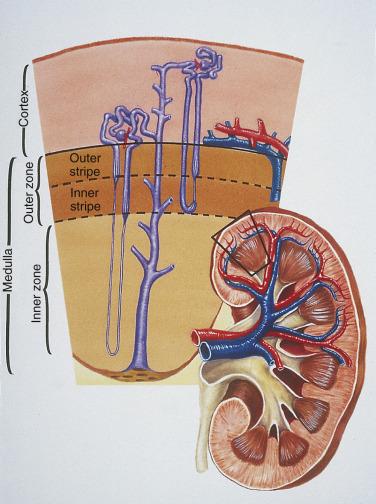
In general, the prognosis for collecting duct carcinomas is poor. A variant of collecting duct carcinoma which occurs predominantly in young patients with sickle cell trait has been given the name renal medullary carcinoma . The prognosis for these patients has been exceptionally bad.
While the collecting ducts are present in the cortex and the medulla, the gross pathologic finding of a tumor arising in the inner medulla ( Fig. 12A.26 ), where most other parts of the renal tubular system are absent, can be an important aid to the diagnosis. Unfortunately precise localization to the medulla is only possible with small tumors and many tumors are too large at the time of resection for the specific site of origin within the kidney to be recognizable. The tumors are usually centered in the medulla, often with extensions into the cortex or hilar tissues. Infiltrative borders and white or grey cut surfaces with central necrosis are typical. A connection with the renal pelvis is common.
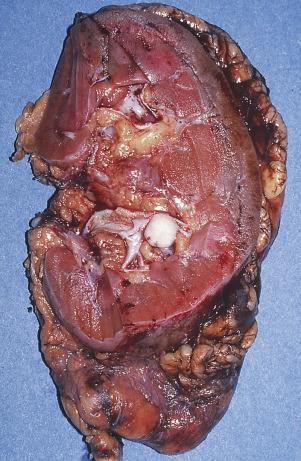
These are distinctive carcinomas with features of adenocarcinoma and urothelial carcinoma. Microscopic examination shows highly irregular ductlike structures, nests, and cords of cells in an abundant loose, slightly basophilic stroma ( Fig. 12A.27 ). The carcinoma cells lining the lumens have small or moderate amounts of cytoplasm and nuclei which are pleomorphic and have thick nuclear membranes. An especially useful feature, rarely found in renal cell carcinoma and not found in urothelial carcinoma, is the hobnail appearance sometimes seen in the cells lining duct lumens ( Fig. 12A.28 ). Rhabdoid morphology is common in these carcinomas. Atypical epithelium in the medullary tubules adjacent to the carcinoma has been seen in some cases.
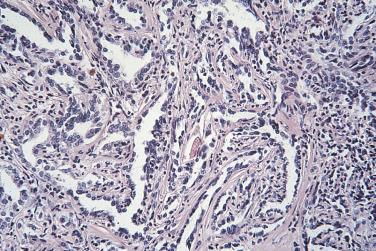
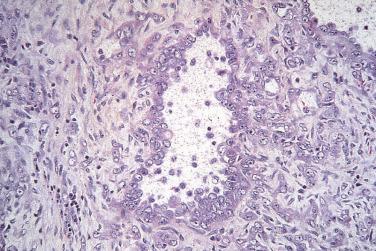
Awareness of collecting duct carcinoma and appreciation of the differences between the microscopic features described earlier and those of other renal cancers should establish the diagnosis in most cases. Untangling collecting duct carcinoma from renal medullary carcinoma can be challenging. If there is evidence of sickle cell mutation, then medullary carcinoma is strongly favored. A positive immunohistochemical reaction for POU5F1 (OCT3/4) also weighs heavily in favor of medullary carcinoma rather than collecting duct carcinoma, as does loss of SMARCB1. High-grade urothelial carcinoma is an important consideration in the differential diagnosis. Immunohistochemistry can be helpful with this. A positive reaction for PAX8 combined with negative reactions for p63 and GATA3 supports a diagnosis of collecting duct carcinoma, while a negative reaction for PAX8 combined with positive reactions for p63 and GATA3 weighs in favor of a diagnosis of urothelial carcinoma. Borderline cases should be diagnosed as renal cell carcinoma, unclassified.
A family of renal carcinomas which contain a variety of translocations involving Xp11.2 has been identified. These translocations result in gene fusions involving TFE3 . This family of carcinomas was classified as Xp11 translocation carcinomas in the 2004 World Health Organization (WHO) classification. Subsequently, carcinomas with a t, producing a fusion with TFEB , have been identified. Since TFE3 and TFEB are members of the MiTF/TFE family of transcription factor genes, it appears possible that further carcinomas may be discovered with fusions of other genes in the family. While carcinomas make up less than 5% of renal tumors in children, translocation carcinomas appear to make up at least 20% of renal carcinomas in children. Translocation carcinomas also occur in adults but their frequency remains unclear. A number of cases have presented at a high stage and have undergone surprisingly indolent courses. Due to the small number of cases studied so far, knowledge of the clinical aspects and outcome of these tumors is somewhat sketchy. There may be more female than male patients but that is not conclusive. Some patients have presented with metastases yet have had prolonged survival. Some patients have had histories of chemotherapy for other conditions.
Translocation carcinomas usually are solid tan-yellow tumors; foci of hemorrhage and necrosis are common.
Xp11.2 translocation carcinomas often have large areas of papillary architecture in which the papillae are covered by cells with abundant clear or pale cytoplasm ( Fig. 12A.29 ). However, they also have an alveolar or nested architecture and cells with eosinophilic cytoplasm are common. Psammoma bodies are common and may be quite numerous. There are subtle variations in morphology among carcinomas with the different Xp11 translocations.
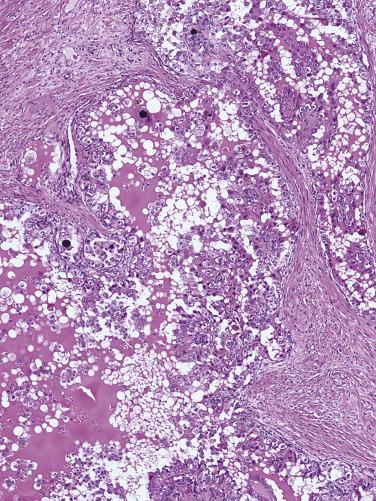
T translocation carcinomas consist of nests and microscopic cysts composed of polygonal cells with pale or eosinophilic cytoplasm. Papillae are uncommon. A distinctive component consists of cells with small amounts of cytoplasm and denser chromatin arranged around nodules of hyaline material in large acini. At low magnification, these resemble rosettes.
Translocation carcinomas with gene fusions involving TFE3 typically show a positive intranuclear reaction with antibodies to TFE3. Carcinomas with gene fusions involving TFEB typically show positive intranuclear reactions with antibodies to TFEB. Xp11 translocation carcinomas characteristically fail to mark or mark weakly with antibodies to epithelial markers, such as epithelial membrane antigen and cytokeratins. T carcinomas are frequently positive for HMB45 and melan-A and contain extracellular eosinophilic nodules which react with antibodies to collagen IV. Cathepsin K is another marker for these carcinomas.
In 2004 it was recognized that germline mutations in genes encoding mitochondrial succinate dehydrogenase can cause renal cell carcinomas. Mutations of SDHB , SDHC , and SDHD also cause familial pheochromocytoma-paraganglioma syndromes and gastrointestinal stromal tumors. The mean age at presentation is approximately 40 years, but several have presented before age 20. Although follow-up is limited, about 15% have died of disease.
The sizes of these carcinomas have ranged widely, with a mean diameter of 50 mm. The tumors are mainly solid, with cystic change in a minority. The cut surfaces of these well-circumscribed tumors have been described as tan to red.
At low magnification, succinate dehydrogenase-deficient renal cell carcinomas give an impression of growth in sheets punctuated by small cysts. Higher magnification shows the cells to be arranged in small alveoli invested by delicate blood vessels. Some of the alveoli expand to form lumina of variable size filled with pale eosinophilic fluid. The neoplastic cells have eosinophilic cytoplasm which usually has a pale flocculent appearance but occasionally is dense and brightly eosinophilic. A distinctive and diagnostically helpful feature is the nearly constant presence of intracytoplasmic inclusions or vacuoles ( Fig. 12A.30 ). Electron microscopy shows that the cytoplasmic inclusions are abnormally enlarged mitochondria. Nonneoplastic tubules and glomeruli are frequently entrapped within the tumor. Sarcomatoid change is found in approximately 10% of tumors and coagulative necrosis in somewhat fewer.
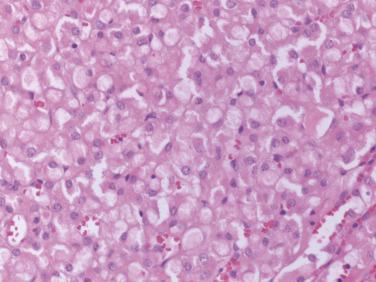
Regardless of which of the genes is mutated, immunohistochemistry for SDHB is negative in the neoplastic cells, while other types of cells staining positively serve as internal controls. A substantial number of tumors which resembled succinate dehydrogenase-deficient renal cell carcinomas have been tested immunohistochemically and found to have normal contents of SDHB. As might be expected, clear cell renal cell carcinomas in which the cytoplasm is richly filled with lipid and glycogen frequently give weakly positive reactions with antibody to SDHB.
Histologically distinctive renal neoplasms composed of cuboidal and spindle cells with mucinous extracellular matrix have been described in reports of single cases and in small series since 1998. Authors have offered a variety of names for these tumors, often referring to their resemblance to tubules of the lower nephron or loop of Henle and to the remarkably low nuclear grade for a carcinoma with areas of spindle cell morphology. At the WHO consensus conference in December 2002, the diagnostic mucinous tubular and spindle cell carcinoma was adopted. All patients have been adults (median age 58 years). There is a roughly 3 : 1 predominance of women over men. Three of the patients reported by Hes et al. also had nephrolithiasis. Approximately 50% of the tumors have been large (stage pT2); in one patient the tumor invaded perirenal fat and in two others there were metastases to lymph nodes. All patients have been treated solely with surgery; no recurrence has been reported.
Mucinous tubular and spindle cell carcinomas have ranged in size from 22 mm to 130 mm in diameter. The cut surfaces are solid and tan brown to pinkish. Some authors have variously described the cut surfaces as gray to white, tan, and yellow to pinkish. Foci of hemorrhage or necrosis has been found in a few of the tumors. One small tumor appeared to be centered on the renal medulla. All but one of the tumors have been well circumscribed and contained within the renal capsule.
Mucinous tubular and spindle cell carcinomas have a distinctive histologic appearance, consisting of cuboidal cells arranged in long cords and tubules and making abrupt transitions to spindle cell morphology ( Fig. 12A.31 ). These epithelial structures are arrayed against a background of lightly basophilic mucinous or myxoid material. The nuclei usually are spherical or oval, have a few small chromatin clumps and small nucleoli. Mitotic figures are uncommon. The spindle cell component may form sheets. The mucinous background material may focally dominate with the epithelial elements forming small cords in lakes of mucinous material. The mucinous background material has little affinity for mucicarmine but reacts strongly with Alcian blue. Plasma cells, mast cells, and clusters of foamy histiocytes are sometimes present. Sarcomatoid change has been reported. The immunohistochemical results obtained in different series have varied. Positive reactions with antibodies to vimentin and epithelial membrane antigen have been the most frequent findings. Reaction with the cytokeratin cocktail AE1/3 was positive in 10 of 14 tumors in two studies. Expression of racemase (P504S) is common. The lectin Ulex europaeus , which binds to collecting duct epithelium, has consistently failed to bind to the cells of mucinous tubular and spindle cell carcinoma.
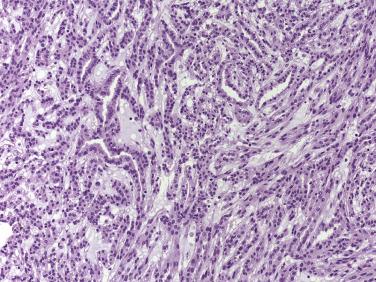
Tubulocystic carcinoma is a recently recognized form of renal neoplasia. In 2004 the term tubulocystic carcinoma was proposed by an international collaborative group and to date three series have detailed the features of 55 tumors. Tubulocystic carcinoma shows a strong gender association with the male to female ratio being 7 : 1. Age at diagnosis is similar to other forms of adult renal cell carcinoma. Patients are often asymptomatic at diagnosis although abdominal pain, distension, and hematuria have been reported.
Tubulocystic carcinoma is usually solitary and well circumscribed. The tumors have ranged from 0.5 to 17 cm in diameter (mean 4 cm) and typically have a white to gray spongy cut surface ( Fig. 12A.32A ).
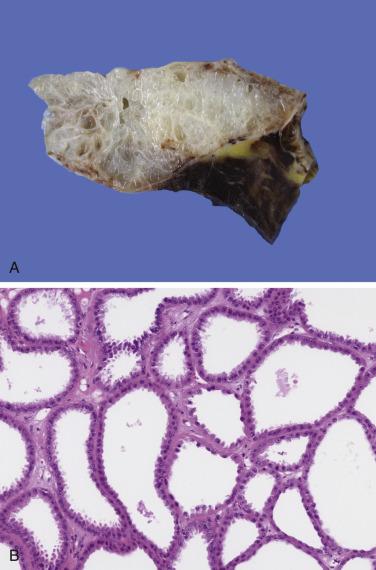
Tubulocystic carcinoma consists of cysts of variable size separated mainly by delicate fibrous septa. Foci of solid growth occasionally are present and usually small. The cysts are lined by cuboidal cells which frequently have a hobnail appearance (see Fig. 12A.32B ). The nuclei usually are nearly spherical and nuclear pleomorphism is slight. Often prominent nucleoli are visible in most of the nuclei. Occasional cases have poorly differentiated foci. The cytoplasm is eosinophilic or weakly amphophilic. Immunohistochemistry is usually positive for cytokeratins 8, 18, and 19; CD-10; racemase (P504S); and parvalbumin while cytokeratin 7 positivity is usually focal.
Tumors that have a cystic growth pattern feature in the differential diagnosis for tubulocystic carcinoma. The lining cells of cystic nephroma often have a hobnail appearance but seldom have prominent nucleoli. Multilocular cystic renal cell neoplasm of low malignant potential is composed of clear cells, rather than cells with eosinophilic or amphophilic cytoplasm and the nuclei rarely if ever contain prominent nucleoli.
While some authors have suggested a linkage between tubulocystic carcinoma and papillary renal cell carcinoma, tubulocystic carcinomas lack trisomy 7 and 17.
In 2006 Tickoo et al. discovered a tumor with papillary architecture and abundant clear cytoplasm in a population of patients with end-stage renal disease and applied to the tumor the name clear cell papillary renal cell carcinoma . In 2008 Gobbo et al. reported examples from patients with normal renal function. Subsequently, studies reporting approximately 80 more cases have been published, clarifying aspects of the clinical, morphologic, immunophenotypic, and genetic features of these neoplasms. Clear cell papillary renal cell carcinoma is the fourth most common type of renal cell carcinoma. There is a male to female predominance of 2 : 1 and all have been found in adults ranging in age from the third to tenth decades, with a mean age of approximately 60 years. The majority of patients have had normal renal function. Although the diagnosis of carcinoma is applied to them, all tumors described to date were localized to the kidney at the time of diagnosis and no recurrence or metastasis has been reported.
Clear cell papillary renal cell carcinoma are usually small at presentation, with reported sizes ranging up to 8.5 cm in maximum diameter. The majority of tumors are cystic, with the cysts often containing serosanguinous fluid. There is often a thick fibrous pseudocapsule and sometimes the largest cysts are at the periphery of the tumor adjacent to the pseudocapsule.
An acinar or glandular architecture usually predominates in these tumors. Papillae are present in approximately 80% of cases, although they often constitute only a minor component. The papillae usually differ in architecture from those of papillary renal cell carcinoma types 1 and 2, and from the papillae of translocation carcinomas. The papillae are less complex, the cores are thicker, and the stroma within them often is cellular ( Fig. 12A.33A ). Additionally, sometimes stubby secondary papillae branch from the primary papillae. This architecture is distinctive, and when present, is strong evidence that the tumor is a clear cell papillary renal cell carcinoma. Nests of cells with clear cytoplasm and delicate vasculature closely resembling ordinary clear cell renal cell carcinoma are common and in a needle biopsy could easily be diagnosed as ordinary clear cell renal cell carcinoma. The cytoplasm is abundant and usually very clear (see Fig. 12A.33B ). On papillae, it is sometimes so voluminous that the apical cytoplasm of the cells on one papilla touches that of the cells on an opposite papilla, creating a broad clear band between the wide cores. Uncommonly the cytoplasm is weakly eosinophilic. The nuclei of the epithelial cells show little pleomorphism and mitotic figures are difficult to find. It is common for the nuclei to be high in the cytoplasm, away from the basement membrane. Psammoma bodies and foamy macrophages are not found in these tumors. The stroma of the papillary stalks and between the epithelial elements is more abundant and more cellular that is expected in an ordinary clear cell renal cell carcinoma and this can be a helpful clue to the nature of the tumor. The stromal cells are mostly nondescript spindle cells but sometimes show smooth muscle differentiation.
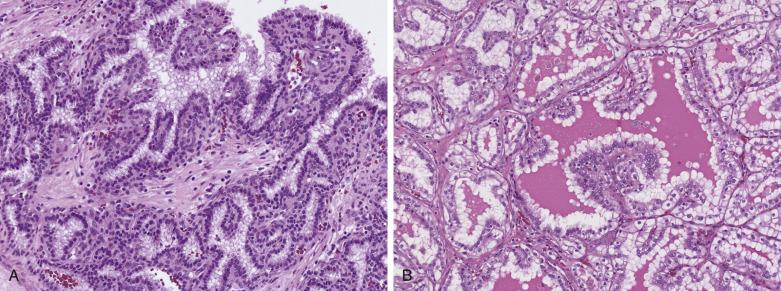
The epithelial elements usually show an immunophenotypic profile which distinguishes them from papillary renal cell carcinoma and clear cell renal cell carcinoma. A diffuse and strongly positive reaction with antibody to cytokeratin 7 is typical, while reactions for alpha methyacyl-CoA racemase and CD10 are consistently negative, with the exception that CD10 can be positive in the cells lining cysts. Less helpful but occasionally useful are the positive reactions for carbonic anhydrase IX and vimentin and negative reactions for TFE3 which are typical of clear cell papillary renal cell carcinoma. While genetic studies on these tumors are limited, it is becoming clear that they have neither the gains of chromosomes 7 and 17 typical of papillary renal cell carcinomas nor the mutations in VHL or losses in chromosome 3p25 which are characteristic of clear cell renal cell carcinomas.
In 2006 Tickoo et al. discovered a tumor with abundant eosinophilic cytoplasm, cribriform architecture, and crystal deposits in a population of patients with end-stage renal disease who had developed acquired cystic disease and applied to the tumor the name acquired cystic disease–associated renal cell carcinoma . Outcome data for acquired cystic disease–associated renal cell carcinoma are limited with one death from metastatic disease, 34 months following diagnosis, being reported. In two other cases regional lymph node metastases were seen.
These tumors are usually well-circumscribed soft brown tumors and, when large, show pseudoencapsulation often with dystrophic calcification.
Microscopically there are a variety of architectural patterns ranging from solid and acinar to cystic and papillary ( Fig. 12A.34 ). The presence of irregular lumina gives the tumor a cribriform appearance. In many of the smaller lesions the tumor appeared to arise in a cyst. The cells typically have abundant eosinophilic cytoplasm with nearly spherical nuclei and a single large nucleolus. Occasional cells have vacuolated cytoplasm and focally clear cells are present. Oxalate crystals are present in the majority of tumors but may be few and difficult to find.
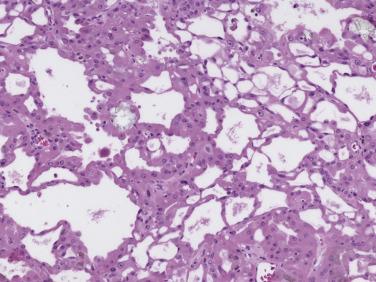
Genetic analysis of acquired cystic disease–associated renal cell carcinoma shows gains of chromosomes 7 and 17. FISH analysis has also shown gains of chromosomes 1, 2, 3, 6, 16, and Y in several cases, with additional gains of chromosomes 1, 5, 11, 12, and X being occasionally seen. Mutations of the VHL gene have not been identified in these tumors.
Renal cell carcinoma, unclassified is a diagnostic category to which renal carcinomas should be assigned when they do not fit readily into one of the other categories. In some surgical series, this group has amounted to approximately 4% to 5% of cases. Since this category must contain tumors with a variety of appearances and genetic lesions, it cannot be defined precisely. Features that should prompt assignment of a carcinoma to this category include apparent composites of recognized types, sarcomatoid carcinoma without recognizable epithelial elements, mixtures of epithelial and stromal elements, and unrecognizable cell types. Since this is a highly heterogeneous group of tumors it is impossible to make generalizations about them.
The extent of spread of renal cell carcinoma is the dominant factor in prognosis. With modern imaging methods and the widespread use of abdominal imaging for many complaints, smaller and smaller renal cell carcinomas have made up larger and larger fractions of the patient population. Partial nephrectomy and laparoscopic partial nephrectomy have become standard approaches to renal cell carcinoma. Nonetheless, surgery or other ablative procedures remain the principal therapy for renal cell carcinoma and for this reason tumors confined within the renal capsule are the theme of the most favorable categories. The TNM system ( Table 12A.1 ) takes into account the correlation between size and survival by dividing this group according to size. Invasion of the perinephric fat within Gerota fascia is the key to the next stage. The next group is more complicated and controversial; renal cell carcinoma frequently invades the renal venous system, which is the criterion for stage 3A. The invasive path is frequently through veins in the renal sinus. Invasion of small veins within the main tumor is not sufficient reason to assign stage 3; rather, the invasion must occur in large veins and must be at the edge or outside of the main tumor. Metastasis to regional lymph nodes without distant metastasis occurs in some cases but more than 50% of patients with enlarged regional lymph nodes have only inflammatory or hyperplastic changes. Radical nephrectomy with regional lymph node dissection was a standard operation for renal cell carcinoma for three decades but the therapeutic contribution of the lymph node dissection remains controversial. Occasionally metastasis occurs via paraureteral veins or lymphatics and for this reason the end of the ureter and its adventitial tissues constitute a relevant surgical margin and should be examined histologically in radical nephrectomy specimens. Improvements in imaging techniques have made it possible to omit resection of the adrenal gland in many cases.
| T Category | T Criteria |
|---|---|
| DEFINITION OF PRIMARY TUMOR (T) | |
| TX | Primary tumor cannot be assessed |
| T0 | No evidence of primary tumor |
| T1 | Tumor ≤7 cm in greatest dimension, limited to the kidney |
| T1a | Tumor ≤4 cm in greatest dimension, limited to the kidney |
| T1b | Tumor >4 but ≤7 cm in greatest dimension, limited to the kidney |
| T2 | Tumor >7 cm in greatest dimension, limited to the kidney |
| T2a | Tumor >7 cm but ≤10 cm in greatest dimension, limited to the kidney |
| T2b | Tumor >10 cm in greatest dimension, limited to the kidney |
| T3 | Tumor extends into major veins or perinephric tissues, but not into the ipsilateral adrenal gland and not beyond Gerota fascia |
| T3a | Tumor extends into the renal vein or its segmental branches, or invades the pelvicalyceal system, or invades perirenal and/or renal sinus fat but not beyond Gerota fascia |
| T3b | Tumor extends into the vena cava below diaphragm |
| T3c | Tumor extends into the vena cava below diaphragm |
| T4 | Tumor invades beyond Gerota fascia (including contiguous extension into the ipsilateral adrenal gland) |
| DEFINITION OF REGIONAL LYMPH NODE (N) | |
| NX | Regional lymph nodes cannot be assessed |
| N0 | No regional lymph node metastasis |
| N1 | Metastasis in regional lymph node(s) |
| DEFINITION OF DISTANT METASTASIS (M) | |
| M0 | No distant metastasis |
| M1 | Distant metastasis |
The nuclear grading system proposed by Fuhrman et al. was recently modified. The current system consists of four grades based on the size and conspicuousness of nucleoli ( Table 12A.2 ). Mitotic figures are not a part of this system but typically are rare in grade 1 and 2 tumors and the finding of more than one per 10 hpf has adverse prognostic significance.
| Grade 1 | Invisible or small basophilic nucleoli with 40× objective |
| Grade 2 | Conspicuous nucleoli with 40× objective but inconspicuous with 10× objective |
| Grade 3 | Clearly visible eosinophilic nucleoli with 10× objective |
| Grade 4 | Extreme nuclear pleomorphism with or without multinucleate giant cells or any amount of sarcomatoid or rhabdoid change |
Neuroendocrine neoplasms in the spectrum from carcinoid to small cell carcinoma and primitive neuroectodermal tumor have been found in the kidney. Arising equally frequently in males and females, patient ages have ranged from adolescence to the ninth decade of life with a mean age of approximately 50 years. A variety of endocrine manifestations have been reported, including cases of the carcinoid syndrome and excess secretion of glucagon. Metastases have been common, even among the cases diagnosed as carcinoid.
While pheochromocytomas arising in the renal sinus and compressing the renal artery appear to be more common than pheochromocytomas within the renal capsule, intrarenal pheochromocytomas also occur and are associated with hypertension. Neuroblastoma rarely arises in the kidneys of adults.
The carcinoids often are well circumscribed and consist of red-tan tissue with areas of hemorrhage and necrosis. Two cases have been described in which dysplastic teratoid elements have been associated with renal carcinoid and an association with horseshoe kidney has been proposed. Renal small cell carcinomas often are large and infiltrate retroperitoneal soft tissues; regional lymph node metastases are common. Renal neuroblastomas are often large, firm tumors with yellow-red cut surfaces with areas of hemorrhage.
Histopathologically, the tumors fill the spectrum from carcinoid to small cell carcinoma and primitive neuroepithelial tumor. The carcinoids consist of cords or nests of cells with the cytologic features characteristic of carcinoid tumors ( Fig. 12A.35 ). At the other end of the spectrum of differentiation, the small cell carcinomas consist of sheets of poorly differentiated cells with darkly staining nuclei and inconspicuous cytoplasm. Neuroblastoma is diagnosed using the same criteria applied in the adrenal gland; the presence of neuropil or Homer-Wright rosettes is helpful in distinguishing it from small cell carcinoma. Intrarenal pheochromocytomas resemble their adrenal counterparts histologically.
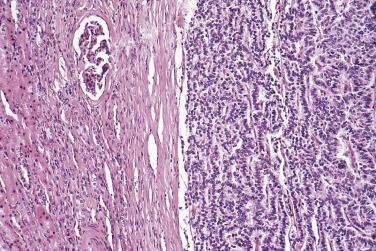
These benign neoplasms of the kidney are composed of fat, smooth muscle, and thick-walled blood vessels in varying proportions. In the adult population, angiomyolipoma is approximately as common as renal cell carcinoma. Angiomyolipomas arise as a result of mutations in TSC1 and TSC2, in keeping with their inclusion in the family of PEComas. In surgical series, approximately half are associated with tuberous sclerosis and half occur sporadically. In patients with tuberous sclerosis, they are usually asymptomatic, multiple, bilateral, and small ( Fig. 12A.36 ), while in the general population they are usually symptomatic, single, and large ( Fig. 12A.37 ). They are uncommon in the general population but more than 50% of patients with tuberous sclerosis develop them. Unlike its close relative, epithelioid angiomyolipoma, angiomyolipoma is benign and the evolution of sarcoma from an angiomyolipoma is extremely rare.
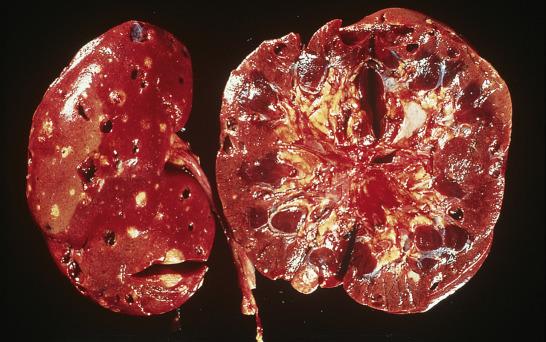
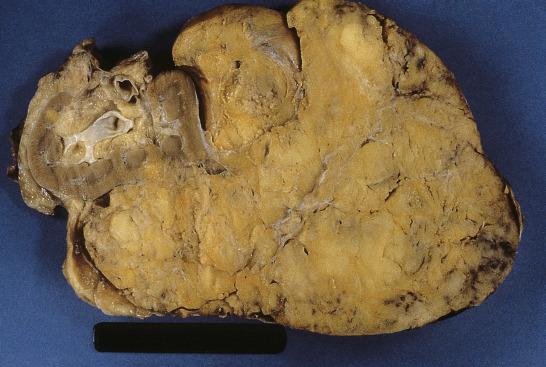
Tumors range from less than a centimeter to 20 cm or more in diameter. The likelihood of symptoms increases above 4 cm and symptomatic tumors average about 9 cm. These tumors are typically golden yellow but the color varies according to the proportions of smooth muscle and blood vessels. They are not encapsulated and, while generally well demarcated, may be locally infiltrative. The appearance of the cut surface of the tumor may resemble that of a lipoma.
The histology of these tumors varies according to the relative proportions of fat, smooth muscle, and blood vessels ( Fig. 12A.38 ). The smooth muscle component is also variable in appearance. A frequent finding is radial arrays of smooth muscle fibers about blood vessels ( Fig. 12A.39 ), but smooth muscle also is found in bundles and scattered as individual fibers. The smooth muscle cells are typically spindle shaped but occasionally polygonal or rounded with an epithelioid appearance and have abundant eosinophilic cytoplasm ( Fig. 12A.40 ). The blood vessels are often abnormal, with thick walls resembling those of arteries but with eccentrically placed or very small lumens. Nuclear pleomorphism may be pronounced and mitotic figures may be present. These findings have no adverse prognostic significance in most cases. In some cases, angiomyolipomatous tissue has been found in regional lymph nodes. This should not be misinterpreted as metastatic sarcoma. Occasionally, angiomyolipoma invades the renal vein or vena cava; all of these patients have been cured surgically so this does not indicate malignancy.
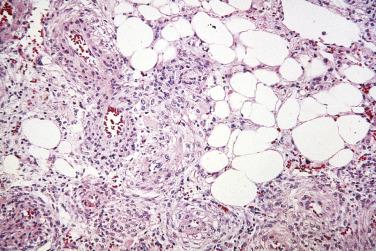

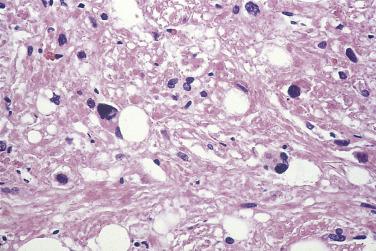
A variant of angiomyolipoma which can easily be mistaken for carcinoma has been categorized as epithelioid angiomyolipoma . The tumors are composed of a mixture of large polygonal cells with abundant eosinophilic cytoplasm, some of which superficially resemble ganglion cells, and short spindle cells. Often there is extensive hemorrhage and edema in the tumors. Immunohistochemistry shows the presence of actin and HMB-45 and the absence of epithelial markers. The diagnosis is clinically important because some of these tumors have progressed and been lethal.
In cases with an extreme predominance of fat, angiomyolipoma can be confused with lipoma; extensive sampling may be necessary to identify the vascular and smooth muscle components of the tumor. Tumors with scant fat may be confused with other mesenchymal tumors, such as leiomyoma. Tumors with epithelioid features may mimic epithelial tumors of the kidney and the possibility should be considered when examining an epithelial-like renal tumor that is hard to classify.
Epithelioid angiomyolipoma has been incorrectly diagnosed as carcinoma at frozen section, in fine-needle aspirations and in permanent sections. It should be considered when confronted by any unusual renal neoplasm composed of poorly cohesive polygonal cells with eosinophilic cytoplasm.
Hemangiomas of the kidney have been found mainly in adults and occur equally in men and women. Solitary lesions are the most frequent, but more than 10% are multiple and bilaterality has been reported. Rarely they may be associated with the Klippel-Trenaunay and Sturge-Weber syndromes. Many are asymptomatic and found only at autopsy. In symptomatic patients, recurrent hematuria is the usual complaint, frequently associated with anemia.
Most are less than 1 cm in diameter and unimpressive to the naked eye. Larger lesions, up to 18 cm in diameter, occur and have a spongy reddish appearance. While hemangiomas may arise anywhere in the kidney, the medulla and papilla are the sites of the majority of symptomatic lesions.
Microscopically, these lesions are composed of vascular spaces of variable size, some of which may have smooth muscle and elastic tissue in their walls. Thrombosis and organization are common. While they often have irregular borders and merge with the surrounding renal parenchyma, the lack of nuclear atypia and mitotic figures should make recognition of their benign nature easy in most cases. They are distinguished from angiosarcomas using the same criteria applied in soft tissue (see Chapter 3 ); this also pertains to the other benign mesenchymal tumors discussed here.
Renal lymphangiomas are much less common than renal hemangiomas. A few dozen cases have been described in patients ranging in age from infancy to old age, about one-third in children and two-thirds in adults. Grossly, most have been solitary encapsulated masses composed of small cysts containing clear fluid. Microscopic examination shows spaces lined by benign endothelial cells with septa that are generally fibrous but may contain smooth muscle. Lesions in the renal sinus may infiltrate the renal medulla, obstructing the flow of urine.
Become a Clinical Tree membership for Full access and enjoy Unlimited articles
If you are a member. Log in here